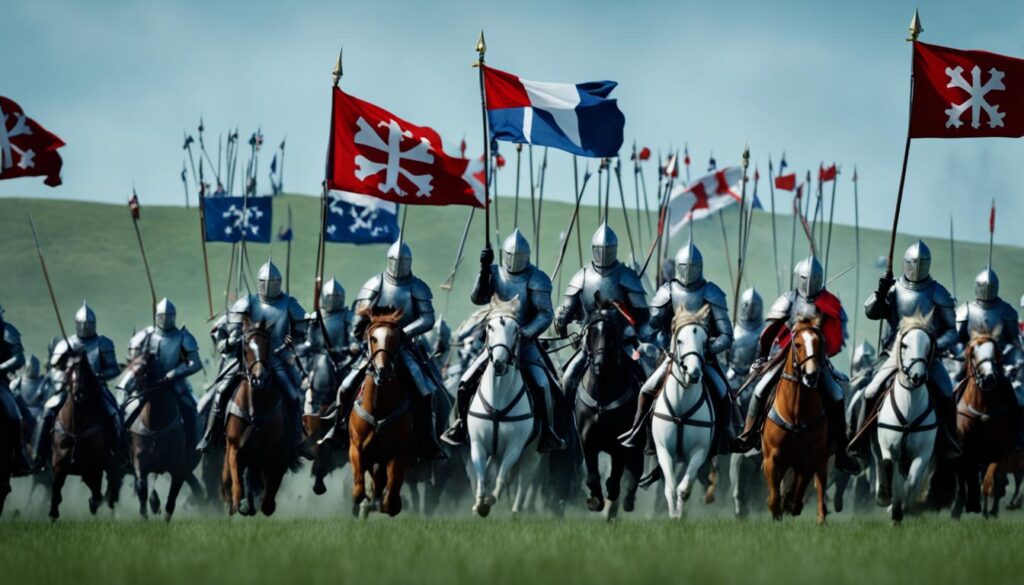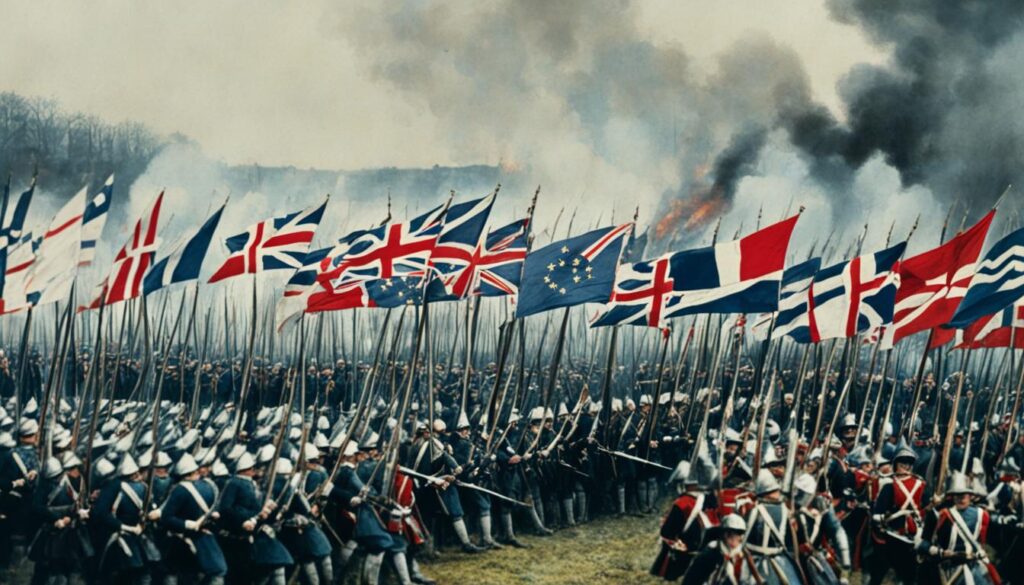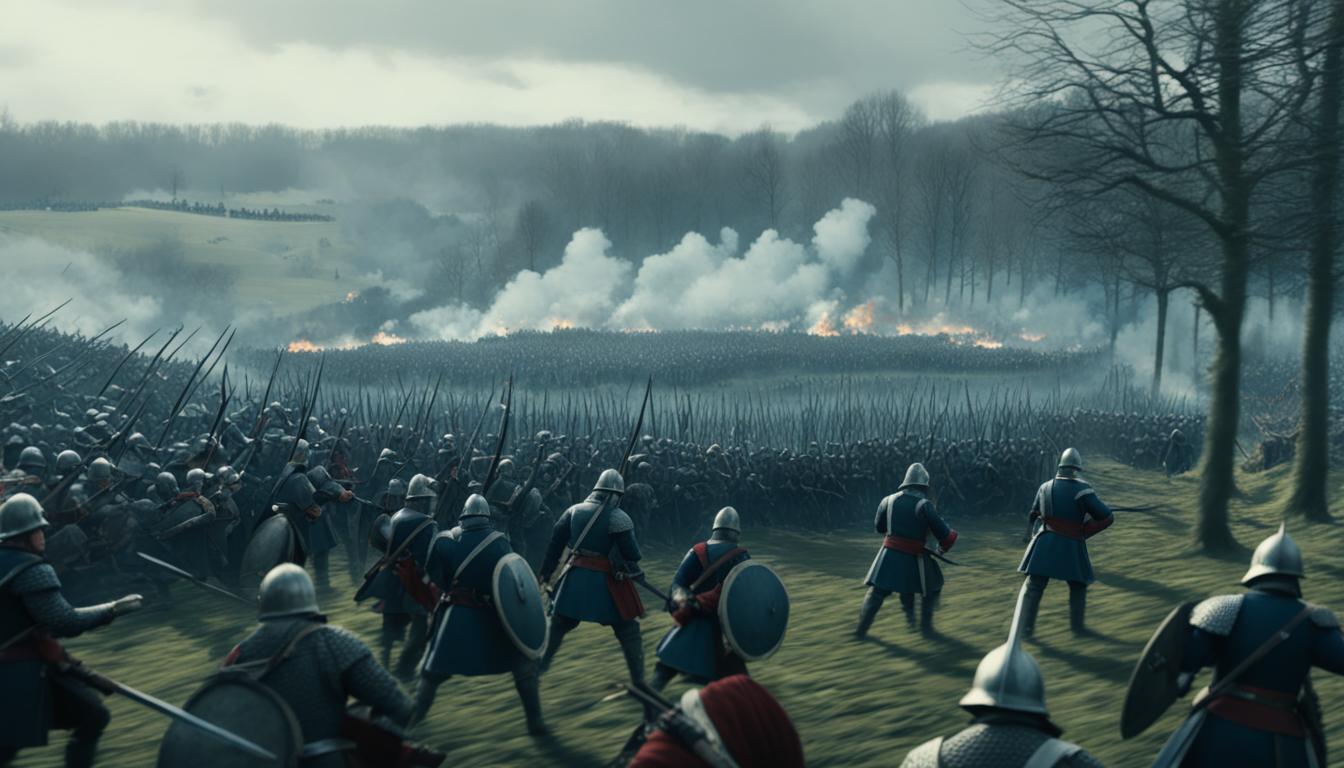When we hear “Hundred Years’ War,” we might think it was a simple century-long fight. But history has a way of surprising us! This Anglo-French conflict actually lasted 116 years and 4 months. From 1337 to 1453, England and France fought in a war that changed medieval Europe.
This war lasted through five generations of kings from two rival houses fighting over the French throne. It wasn’t one long, steady fight. Instead, it was a mix of battles with breaks in between. These breaks often happened because of big events, like the deadly Black Death.
During this long time, how armies fought changed a lot. New weapons and tactics came into play, changing war forever. It also showed the end of chivalry and the start of stronger national identities in England and France.
Key Takeaways
- The Hundred Years’ War lasted 116 years and 4 months (1337-1453)
- Five generations of kings from rival dynasties fought for the French throne
- The war was a series of conflicts with intermittent periods of peace
- External factors like the Black Death interrupted the fighting
- The conflict led to innovations in medieval military tactics
- It contributed to the decline of chivalry and rise of national identities
Origins and Causes of the Hundred Years’ War
The Hundred Years’ War started from the complex relationship between the French and English crowns. Disputes over English lands in France, like Gascony, caused tension. The Plantagenet Dynasty of England wanted to keep these lands, while the House of Valois wanted to rule all of France.
In 1328, a crisis happened after Charles IV of France died. Edward III of England claimed the French throne through his mother Isabella. This challenged the Salic law, which said women couldn’t inherit the throne in France. Philip VI of the House of Valois took the throne, making things worse.
The Salic law became a big issue. It stopped Edward III from getting the throne, leading him to try to take it by force in 1337. This started a long fight between the two kingdoms. It was about family feuds and wanting more land.
The Three Phases of the Anglo-French Conflict
The Hundred Years’ War had three main phases. It began in 1337 with the Edwardian Phase. This phase saw English wins at Crécy and Poitiers, showing the power of English longbowmen against French knights. King John II of France was captured at Poitiers in 1356, which was a big blow to French spirits.
The Caroline Phase started in 1369 and showed French strength. Under King Charles V and Bertrand du Guesclin’s leadership, France made big gains back. This period moved from big battles to guerrilla tactics, making it hard for the English to keep control of French lands.

The Lancastrian Phase began in 1415 with Henry V’s invasion of France. The English win at Agincourt lifted their spirits, showing the best of chivalric warfare. But French resilience was clear again. With Joan of Arc’s help, Charles VII led a strong comeback. The French win at Castillon in 1453 ended the war, closing a chapter of long conflict that changed medieval Europe.
Hundred Years’ War Duration: 116 Years of Intermittent Conflict

The Hundred Years’ War lasted an astonishing 116 years, 4 months, and 3 weeks. It started on May 24, 1337, and ended on October 19, 1453. This war was not a constant fight for a century but had breaks in between.
The war was interrupted by the Black Death, changing medieval Europe’s politics and society. Historians named it the “Hundred Years’ War” in 1823. Some believe these conflicts started as early as 1066 with William the Conqueror.
The Longbow Superiority was key to many English wins. This tactic changed the outcome of battles and made the war last longer. Even after the war ended, its effects were still felt. The English kept Calais until 1558 and claimed the French throne until 1800, showing the war’s lasting impact.
Legacy and Consequences of the Prolonged Struggle
The Hundred Years’ War had a big impact on England and France. It changed how countries were run and fought wars. France’s monarchy got stronger, while England’s Plantagenet dynasty weakened. This war helped shape the identities of both countries.
During this time, medieval military tactics changed. Longbows and artillery became more common, changing battles. Chivalric warfare started to fade, replaced by professional armies.
England lost most of its land in France, keeping only the Pale of Calais. But both countries became more unified. They started to look beyond their borders, setting the stage for future global influence. The war’s end marked a turning point, as England and France began to shape the world we know today.

Leave a Reply